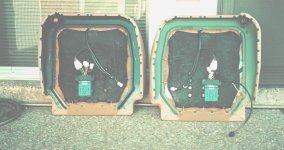Basil,
Since you have access to a paint booth you could use a paint with hardner such as PPG Acrylic Urethane which is a single stage (no clear) but that will require the appropriate reducers/hardners which makes it a pricey solution (unless you plan to paint other things the same color). Or you could use engine enamel from someone like Hirsche but the finish won't be quite as nice. BTW, a semi gloss will probably look better since high gloss shows every little defect.
Yes, use a good primer .. I like to start with a self etching primer to get good adhesion to the steel. Only use a thicker high solids primer if you have surface defects to cover/level.
Quick tutorial.
1. Remove all old paint with a stripper or mechanical method (sanding, wire brush, sand blast).
2. Clean metal with lacquer thinner or mineral spirits. If you suspect any silicone contamination you can wipe down with PrepSol (from auto paint store). If you do have silicone on the surface your first coat will 'fish eye' (paint won't adhere in spots forming small round depressions) Figure out a way to hang the tank by a wire/fixture so you can paint the whole thing at one time by turning. You don't want it flapping around though .. sometimes two wires are needed to stabilize the part with hooks that the top to turn things around. Remember you need easy access to the top, bottom, sides, too.
3. prime with self etch primer (good way to practice with your spray gun). BTW, you will need clean dry air. I like to use a small disposable filter at the base of the gun along with an air regulator there to allow fine adjustments.
4. Read the directions on your self-etch primer. There is usually a window of time between primer and top coat where you don't need to sand. If you go over you may have to scuff the self-etch to get good adhesion with the top coat. I usually use a fine scotch bright type pad (from auto body store) to scuff the surface.
5. Stir the paint thoroughly, empty into a similar container so you can make sure the bottom of the can is clean (all the good stuff settles to the bottom). Thin the top coat per the directions. Use a paper cone type paint strainer as you transfer the mixed paint into the gun.
6. Using the spray gun. This is tricky to explain because there are so many variables such as paint thick vs. thin. type of paint, spray pattern, type of gun. All I can say is experiment with some spare panels. Play with the air pressure .. see what happens if it it too low (heavy texture, splatters, not much atomization). It the air pressure is too high you will see paint blowing all over the place, runs, lots of paint hitting the surface. You want something in between. Play with the spray pattern adjustment. All the way in one direction will make a dot pattern (not good unless you are shooting in a very tight space) to a very wide pattern, possibly heavy at the each end. So you want a fairly wide pattern but don't open it wider than that. Play with the paint volume control. Usually something in the middle will give you plenty of paint for fairly large objects like a fuel tank.
You want to always keep the spray gun moving when you are applying paint. The first part of the trigger is air. I keep the air on all the time when painting as this keeps the tip clear. I start moving the gun and then pull the trigger in all the way which starts the paint. The speed is adjusted as you watch the paint hit the surface so that you get good consistant coverage. If you go too fast the coverage will be light, if you go too slow you will get too much paint and risk runs. Better to error slightly on the light side and do more coats until you get more experience. Try to keep the gun 90 degrees to the surface being painted at all times. It takes lots of wrist awareness and movement to keep the gun perpedicular as you sweep back and forth, overlapping each pass about 50%. Think of your body, arm, wrist as a painting robot and control the passes as consistantly as possible. /bcforum/images/%%GRAEMLIN_URL%%/smile.gif Start and stop the spray beyond the part so you will get even coverage at the edges.
Even though you will be using a spray booth, use an respirator, goggles, and cover exposed skin as much as possible. Especially if you using a paint with hardners.
Hopefully you can find someone to help set you up and give some pointers. It's not terrible difficult but so many little things can and do go wrong with painting that experience is a big advantage.
Cheers,
John
p.s. here is link I saved on setting up the Harbor Freight HPVL gun (o.k. gun for some stuff including primers .. I prefer Sata for final finishes)
HF paint gun setup
 Hi Guest!
Hi Guest!

 smilie in place of the real @
smilie in place of the real @
 Pretty Please - add it to our Events forum(s) and add to the calendar! >>
Pretty Please - add it to our Events forum(s) and add to the calendar! >> 
